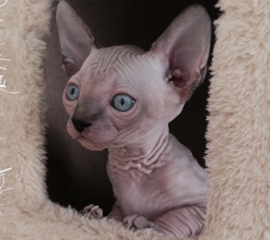The most particular component of this feline is its appearance of baldness. The Sphynx is of medium size and body compliance with astounding load for its size. The body feels warm and delicate to the touch, with a skin surface similar to either a delicate peach or a smooth nectarine. To buy sphynx kitten is good-natured, enthusiastic, and manageable to taking care of.

History:
The Sphynx isn’t the first occasion of smoothness in quite a while. This regular, unconstrained change has been seen in different areas around the globe for over a century, and most likely any longer. The Book of the Cat by Frances Simpson, distributed in 1903, referenced a couple of dark and white bare felines, Dick and Nellie, with an Albuquerque, New Mexico feline darling named F. J. Shinick. Called the “Mexican Hairless,” these felines seemed to be like the present Sphynx and were acquired from Indians around Albuquerque. As per Mr. Shinick’s letter, “The old Jesuit Fathers disclose to me they are the remainder of the Aztec breed known uniquely in New Mexico.” It’s obscure if that was valid. However, Dick and Nellie passed on without delivering posterity.
In 1950, a couple of Siamese felines in Paris, France, delivered a litter that included three bare little cats. The outcomes were rehashed in ensuing matings of a similar pair, however, rearing the guardians to other Siamese felines delivered no new bald small cats. Different hairless cats turned up in Morocco, Australia, North Carolina, and, in 1966, in Roncesvalles, Toronto, Ontario, Canada, where a couple of domestic shorthairs created a litter that incorporated a bare little cat named Prune. A reproducer got the guardians and started a rearing system; the variety was called the Canadian Hairless. Prune was mated with his mom, which created one bare cat.
The breaking period of the 1970s:
In 1970, CFA conceded temporary status to the variety. This line had various challenges; the genetic stock was constrained, and a few little cats kicked the bucket from undiscovered medical issues. In 1971, CFA pulled back the acknowledgement because of the variety’s medical problems. The remainder of Prune’s line was sent to Holland to Dr. Hugo Hernandez during the 1970s. In 1978 and 1980, two smooth female little cats accepted to be identified with Prune were found in Toronto. They were sent to Holland to be reproduced with Prune’s last enduring male relative. One female imagined, yet she lost the litter. None of Prune’s relatives proceeded to turn into the Sphynx breed we know today.
In 1975, Minnesota ranch proprietors Milt and Ethelyn Pearson found a bare little cat had been destined to their ordinary covered homestead feline, Jezabelle. This little cat, named Epidermis, was joined the following year by another smooth cat named Dermis.
At nearly a similar time (1978), Siamese raiser Shirley Smith of Toronto, Ontario, Canada, discovered three smooth little cats in the city of her neighbourhood, which she named Bambi, Punkie, and Paloma. The relatives of Bambi, Punkie, and Paloma in Canada, alongside the relatives of Epidermis and Dermis in Oregon, turned into the establishment of the present Sphynx. The variety has made huge steps since its origin. At the same time, most fanciers have invited the Sphynx as unique and fascinating; a few individuals from the extravagant feline wish that the Sphynx would get into some garments. Like different varieties that have wandered from the essential structure, the Sphynx has drawn some negative consideration. Furthermore, the quality that administers baldness can be viewed as a hereditary issue, since the feline is more helpless to both warmth and cold.


